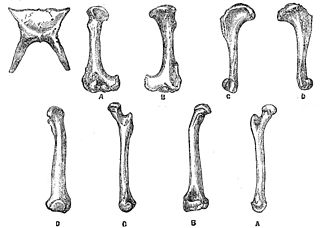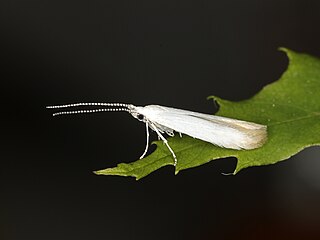
The Rodrigues giant day gecko is an extinct species of day gecko. It lived on the island of Rodrigues and surrounding islands and typically dwelt on trees. The Rodrigues giant day gecko fed on insects and nectar, and, unlike most other day geckos, was apparently nocturnal in habit.
This article is a list of biological species, subspecies, and evolutionary significant units that are known to have become extinct during the Holocene, the current geologic epoch, ordered by their known or approximate date of disappearance from oldest to most recent.

The chestnut casebearer moth is a species of moth in the family Coleophoridae. It is endemic to the United States, where it is found in Indiana, Massachusetts, Pennsylvania, and Virginia. It is a highly specialized species, its larvae feed specifically on the leaves of the American Chestnut. It was thought the species became extinct when many American chestnut trees died due to an infection of the fungus Cryphonectria parasitica, which was accidentally introduced from Asia around 1900. However, this species was rediscovered.
The confused moth is an extinct species of moth in the family Noctuidae.
The Laysan dropseed noctuid moth was a species of moth in the family Erebidae. The species was first described by Otto Herman Swezey in 1914. This species is now extinct.
The Hilo noctuid moth was a moth in the family Erebidae. The species was first described by Otto Herman Swezey in 1912. It was endemic to the island of Hawaii and is now extinct.
The Kaholuamano noctuid moth is an extinct moth in the family Erebidae. The species was first described by Edward Meyrick in 1928. It was endemic to the Hawaiian island of Kauaʻi, but is now considered extinct.

The Kona giant looper moth is an extinct species of moth in the family Geometridae. The species was first described by Edward Meyrick in 1899. It was endemic to Hawaii.
Tritocleis is monotypic moth genus in the family Geometridae described by Edward Meyrick in 1899. Its only species, Tritocleis microphylla, the ʻOlaʻa peppered looper moth, described by the same author in the same year, is now extinct.

Drosophila lanaiensis is an extinct species of fly in family Drosophilidae that was endemic to Hawaii. It lived on Lānaʻi, and possibly on Oʻahu.
Phyllococcus oahuensis is an extinct species of mealybug in the family Pseudococcidae, and the only species in the genus Phyllococcus. It was endemic to Hawaii.
The Castle Lake Caddisfly Rhyacophila amabilis is an extinct species of insect in the caddisfly family Rhyacophilidae. It was endemic to the United States. It was first reported as extinct in 1986.
Melicope mucronulata is a species of plant in the family Rutaceae. It is endemic to the Hawaiian Islands. It is threatened by habitat loss. It is a federally listed endangered species of the United States. Like other Hawaiian Melicope, this species is known as alani.




